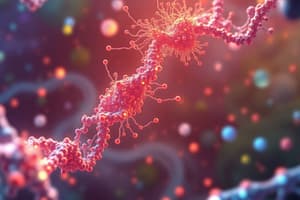Podcast
Questions and Answers
What is the primary purpose of biological databases?
What is the primary purpose of biological databases?
To understand and explain biological phenomena, as well as facilitate the fight against diseases and develop medications.
What is a common challenge in managing biological databases?
What is a common challenge in managing biological databases?
Ensuring the consistency of information across different databases.
What is the primary function of a database?
What is the primary function of a database?
To store, search, and retrieve vast amounts of information.
What was one of the first biological sequence databases?
What was one of the first biological sequence databases?
What is the purpose of accession numbers in biological databases?
What is the purpose of accession numbers in biological databases?
What is the significance of central, shareable resources in biological databases?
What is the significance of central, shareable resources in biological databases?
What is the relationship between primary and secondary databases?
What is the relationship between primary and secondary databases?
What is the role of bioinformatics tools in biological databases?
What is the role of bioinformatics tools in biological databases?
What is a composite database?
What is a composite database?
What is the significance of data formatting in biological databases?
What is the significance of data formatting in biological databases?
Flashcards are hidden until you start studying
Study Notes
Biological Databases
- Types of biological databases:
- Nucleic acid databases (e.g. GenBank, EMBL, DDBJ)
- Protein databases (primary: PDB, MMDB; secondary: Swiss-Prot, Pfam)
- Whole genome databases (e.g. TIGR)
- Metabolic pathway databases (e.g. EMP, KEGG)
- Organism-specific databases (e.g. Ebola, S. aureus, A. thaliana, mouse genome)
Important Bioinformatics Databases
- GenBank: nucleotide sequences
- Ensembl: human/mouse genome and others
- PubMed: literature references
- SWISS-PROT: protein sequences
- InterPro: protein domains
- OMIM: genetic diseases
- PDB: protein structures
- KEGG: metabolic pathways
Why Biological Databases?
- Need for storing and communicating large datasets
- Make biological data available to scientists in computer-readable form
- Support large-scale analysis efforts
- Make data access easy and updated
- Link knowledge obtained from various fields of biology and medicine
Characteristics of Biological Databases
- Depend on the nature of information stored (sequences, images, etc.)
- Depend on the manner of storage (flat files, relational databases, etc.)
Importance of Biological Databases
- Assist scientists in understanding biological phenomena
- Facilitate the fight against diseases
- Assist in the development of medications
- Help in discovering basic relationships amongst species in the history of life
Studying That Suits You
Use AI to generate personalized quizzes and flashcards to suit your learning preferences.




